British Columbians recently gained yet another reason to be deeply proud of our magnificent and biodiversity-rich province: it is now home to the second United Nations-designated Global Geopark in North America! The honour goes to the town of Tumbler Ridge and its surroundings, in the Peace Region of northeast BC. This area is rapidly becoming famous for its geological and biological marvels, including gorgeous mountains, dramatic waterfalls, abundant mineral deposits, rich biodiversity, and fossil dinosaurs and their trackways.

The Boulder Gardens, one of the many geological wonders near Tumbler Ridge. (Charles Helm)
Dinosaurs, did I say? Yes, Tumbler Ridge is home to the Peace Region Palaeontology Research Centre, where researchers have documented a rich variety of fossil discoveries in the Tumbler Ridge region, including the remarkable discovery of the tracks of three Tyrannosaurus individuals walking side-by-side, some of the strongest evidence so far that these amazing predators traveled in packs.
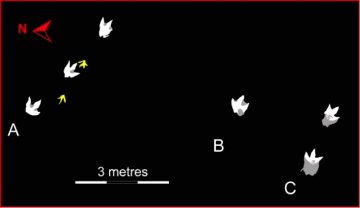
A diagram of the three sets of Tyrannosaur tracks found near Tumbler Ridge. (Rich McCrea)
My own interaction with Tumbler Ridge began in 2005, when I was searching for the contact zone between western and eastern populations of a group of birds called winter wrens. After travelling widely across BC and Alberta, I sort of stumbled on this small town and stopped at a trailhead just outside of it, labeled the Quality Creek Falls trailhead. It was there that I heard two different types of winter wren singing near each other. After a full behavioral and genetic study, this find led to the official designation of winter wrens as two species, the Pacific wren (the species we have in most of BC, including Vancouver) and the winter wren (the species spanning from northeast BC to eastern Canada). The town has recently updated their sign at the trailhead with information about this discovery, using a graphic provided by the Beaty Biodiversity Museum.
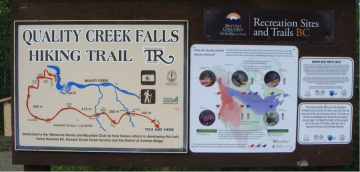
The new Quality Creek Falls trailhead sign, with a graphic illustrating the results of Beaty-museum-based research on how the region is a meeting place between western and eastern bird species. (Charles Helm)
But aside from the wrens, what a wonderful experience it was getting to know the town of Tumbler Ridge! This small town (currently about 3000 people) was built in the early 1980s to support the metallurgical coal mines that were being established in the area. Since, then, mining has undergone cycles of booms and busts, but the residents’ enthusiasm for the natural wonders of the area has grown continuously and dramatically.
An important discovery was made in 2000, when two young boys, Daniel Helm and Mark Turner, noticed a series of large footprints in the rock along the edge of a river they were rafting along. This find led their father, physician Charles Helm, to call in palaeontologist Rich McCrea, who identified the tracks as belonging to an ankylosaur, a type of herbivorous dinosaur that lived during the Jurassic and Cretaceous periods (a span of time between roughly 200 to 65 million years ago). This event was the initial spark that led to the establishment of the Tumbler Ridge Museum Foundation (founded by Charles Helm), the formation of the Peace Ridge Palaeontology Research Centre (led by palaeontologists Rick McCrea and Lisa Buckley), and the long campaign for the region to become a UN-designated Global Geopark.
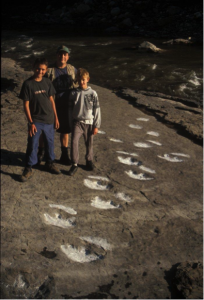
Palaeontologist Rich McCrea poses with Mark Turner and Daniel Helm, discoverers of the ankylosaur trackways, highlighted with chalk, near Tumbler Ridge. (Charles Helm)
As part of their campaign, the town organized a Tumbler Ridge Aspiring Geopark Symposium in July 2013. I was one of a very diverse group of speakers from across Canada—participants learned about geology, biology, history, tourism, mining, hiking, and climbing, all in terms of how they relate to the Geopark concept. I spoke on how birds of the Tumbler Ridge area can be viewed as “important geological phenomena,” a critical aspect of the Geopark concept, since current bird distributions and variation reflect past geological events such as ice age glaciations. Participating in the symposium was a wonderful experience, because of the breadth of expertise of the speakers as well as the sense of enthusiasm and pride of local people for their natural surroundings.
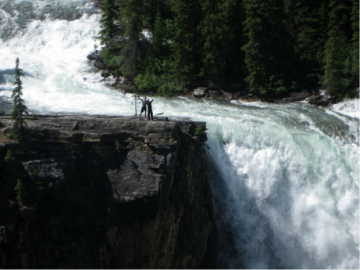
Brooks Falls, one of the many impressive waterfalls in the Tumbler Ridge area. (Linda Helm)
The decision to accept the Tumbler Ridge Aspiring Geopark proposal and establish the Tumbler Ridge Global Geopark was announced last week at the 6th International UNESCO Conference on Global Geoparks, which was held at North America’s only other geopark, the Stonehammer Global Geopark in New Brunswick, Canada.
On behalf of the Beaty Biodiversity Museum, I wish to warmly congratulate the many residents of Tumbler Ridge who have worked tirelessly on the campaign to have their region recognized for its globally important natural heritage!
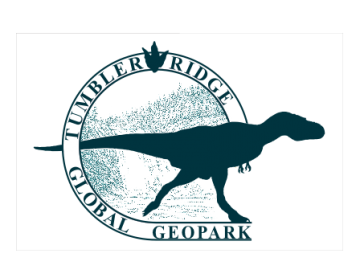
The logo of the new Geopark.
To learn more, see:
UNESCO announcement of 11 new Geoparks added in 2014
Global Network of National Geoparks
Tumbler Ridge Museum Foundation
Tumbler Ridge News article on geoparks
